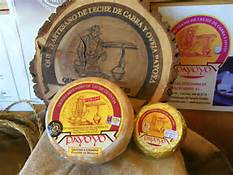Like most rural regions, the Sierra de Grazalema has its own local produce and I have sampled (and purchased) some of its very fine specialities.  This article is, I hope, useful information for anyone about to travel in the region and of interest to anyone who likes good, authentic produce and dishes, though few are exported (the locals know what’s good).
This article is, I hope, useful information for anyone about to travel in the region and of interest to anyone who likes good, authentic produce and dishes, though few are exported (the locals know what’s good).
A lover of cheese of all kinds, I was in my element in Grazalema which has specialist cheese shops or quesarias scattered through the town. The most famous cheese, made there and other villages in the Sierra, is the Payoyo. Made from goats milk, you can find it on the best menus in Andalucia and elsewhere in Spain, though not, as yet, more widely. Young Payoyo is fresh and clean tasting, whereas aged Payoyo is a much harder, more flavourful cheese and there are cured and semi-cured varieties, cheeses rolled in crushed pimenton or mixed with herbs. I bought a medium aged uncured type which was delicious when eaten later (it didn’t last very long back in London).
Unfortunately airport security restrictions prevented me from bringing back to England another Sierra speciality, honey. This is special because of the pinsapar, the Iberian pine  forests, which grow in the park (and elsewhere in Andalucia) but nowhere else. It gives the honey a highly distinctive flavour and is often teamed, in jars, with pine nuts (and almonds and walnuts). Delicious.
forests, which grow in the park (and elsewhere in Andalucia) but nowhere else. It gives the honey a highly distinctive flavour and is often teamed, in jars, with pine nuts (and almonds and walnuts). Delicious.
Though we lunched in Grazalema I could not find the other delicacy of which I’d heard, potaje con tagarninas, a soup made with thistleheads, but I did enjoy the classic Andalucian puchero, a casserole with chickpeas and pork. It was tasty and warming – just as well, because we were sitting outside (we were accompanied by three dogs). My friend and I were warm enough, but the dogs were not. We were, after all, quite high up and the temperature had reduced dramatically as soon as we started to climb. Once the meal was over and coffee arrived, time for a quick cuddle for warmth (the third on my lap).
Said dogs could have benefited from a woollen coat and wool is a Grazalema industry. Formerly a major producer of wool in the days before the industrial revolution, Grazalema faced economic ruin in the 19th century when woollens were made more cheaply elsewhere. Today only a vestige of that trade remains, in one small woollen mill (the oldest in Spain) producing exquisite (and quite expensive) woollen garments and cloth. The Mantas de Grazalema are famous within Spain and beyond. Unfortunately (or perhaps fortunately for my purse) we didn’t have time to make a visit.
Each village has its own specialities and another that we visited (so that I could bring back its produce to a chorizo-loving spouse) was El Bosque, famous  for its trout fishery, but also for excellent meat products, mostly made with pork. I bought several different types of sausages, chorizo and morcilla and can attest to their excellent quality (especially the chorizo). It was also where we stopped for refreshment before heading home and were treated to a magnificent sunset amid the autumnal colours (though the photograph, right, does not do it justice). By this time the mist had already come down to lie heavy on the mountains behind us. Sufficiently restored, we drove off into said sunset, back to the city.
for its trout fishery, but also for excellent meat products, mostly made with pork. I bought several different types of sausages, chorizo and morcilla and can attest to their excellent quality (especially the chorizo). It was also where we stopped for refreshment before heading home and were treated to a magnificent sunset amid the autumnal colours (though the photograph, right, does not do it justice). By this time the mist had already come down to lie heavy on the mountains behind us. Sufficiently restored, we drove off into said sunset, back to the city.
If you enjoyed reading this article you might like others about the Sierra de Grazalema Journey in the Pinsapar Grazelema The Journey Continues


 RSS – Posts
RSS – Posts